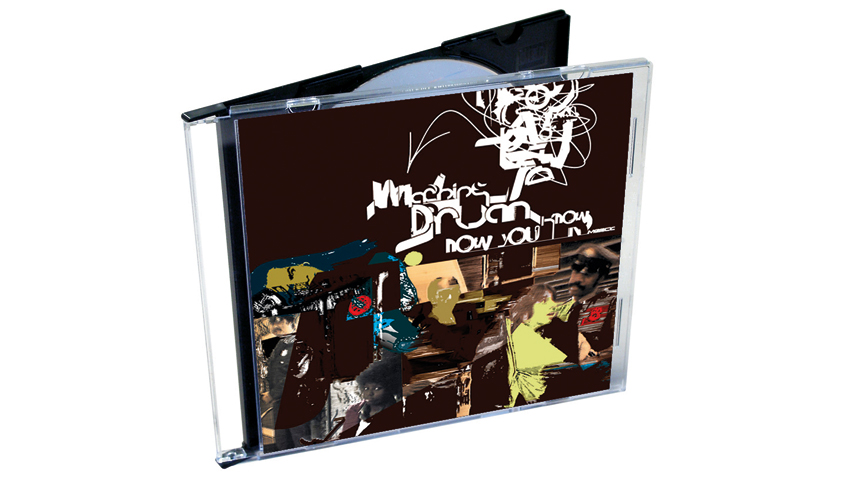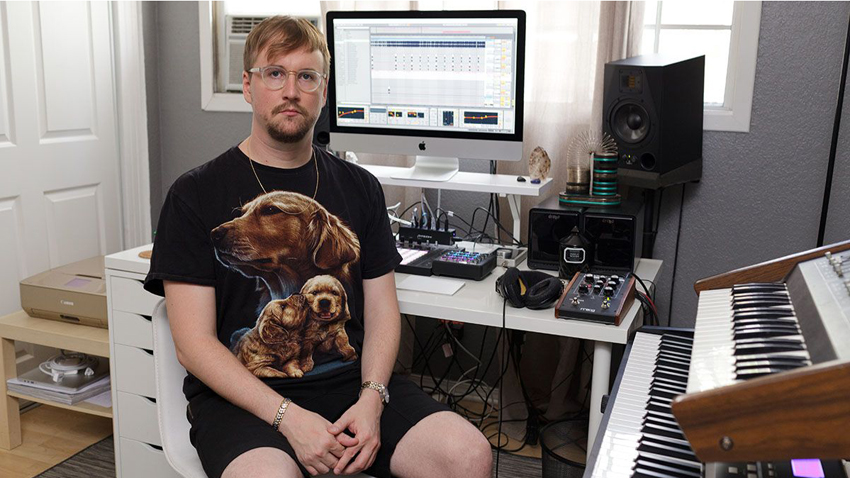Classic album: Machinedrum on Now You Know
Travis Stewart takes on a track-by-track tour of his genre-mashing 2001 debut

Travis Stewart conceived of the Machinedrum project while still in high school. He was experimenting with complex rhythms, underground hip-hop editing, and the junglistic tempos and noise palettes favoured by the UK’s own drill ’n’ bass pioneers. The resulting hybrid caused a stir in the electronic music scene, and swung a spotlight on the young virtuosic producer, in which he’s remained to this day.
His debut album, Now You Know, is a riot of sound splicing and energising beat evolutions, anchored by a gift for soothing textures and melody. It’s the blueprint of what would become the Machinedrum sound - original, daring, cannibalistic, fresh, yet rich in a humour the early material liked to play with.
“That was an important component in the early Machinedrum work,” says Stewart. “I was having a lot of fun with it. My other project at the time, Syndrone, was on a very serious and academic tip. Machinedrum was my chance to get a bit less serious with my work and get some humour into it as well.”
Hello My Future takes its hook from the internet dating profile of a geeky teenage boy, while album opener - the pun-derfully titled Big Beauty Hose - uses spasmodic acapella chopping to try and convince the listener their CD player is skipping.
“It was all about experimenting,” says Stewart. A graduate of steel drum bands, Jazz troupes, and African percussion ensembles in his native North Carolina, he also took these exotic grooves into his production. “I was really interested in polyrhythms at the time,” he says. “The bands I was in would rely heavily on that, so I tried to incorporate that into my music, and mix it with the electronic and hip-hop acts I was into.”
Now You Know shows its influences yet, crucially, also manages to find its own unique voice. It’s ground zero for Machinedrum, and it was the vehicle with which Travis Stewart would steer the rest of his life. “I was still at school, working two jobs before that,” he says. “This album ended up setting up my career. I’ll never forget it.”
Here, Travis takes us through Now You Know, one track at a time…
Get the MusicRadar Newsletter
Want all the hottest music and gear news, reviews, deals, features and more, direct to your inbox? Sign up here.

Big Beauty Hose
“It starts with a heavily cut-up vocal sample. I wanted to trick people into thinking that the CD was skipping when they put it in! When I would play with vocal samples and soloed that channel, it reminded me of a CD skipping, so I always had an idea to do something with that.
“I remember going through and manually editing it. When the track finally comes in, you can hear the triplet rhythms of the cut-up vocals. That’s what I started with, and basically deconstructed that until it sounded like random blips, then, when it dropped, it all came together. It was a lot of fun. I was working in very high resolution in Impulse Tracker, so the patterns would just fly by.”
Wishbone Be Broken
“This was one of the first tracks in which I ever experimented with cutting up a pre-existing rap track. The sample is from Population Control by Company Flow. You can hear El-P’s voice.
“I’d been working on this cut-up stuff for a while, and then when I started sending the tracks over to Gabe [label boss] at Merck, he was like, ‘You should really listen to this’. And he sent me a link to Prefuse 73 and I was like, ‘Oh. Alright. I guess he’s beaten me to the punch!’ [laughs].
“It was cool. It meant that I was onto something. If one of my favourite labels in the world was putting stuff like this out [Warp], then I was doing something right.”
Drums Of Steel
“This would be my version of an interlude. It was a recording of the steel drum ensemble I was part of at the time. I believe I was just running it through a bunch of FX.
“It’s part of the more experimental side of my work at the time. I was doing a lot of experimenting with Sound Forge. I loved using it. It was a big part of my production process. I would do a lot of post-production in it where I would bounce the whole track into it.
“The idea was to just to do constructive editing on the track and see where it would lead me.”
Hello My Future
“This was one of my favourite tracks off the album, and still is. I’ve recently made a version of it for some of my encores - it’s on a jungle/juke vibe. The little boy’s sample of the phrase, ‘Hello, my future…’ that’s scattered throughout is an 11-year-old nerdy kid I sampled off the internet who had basically made this adorable DIY dating profile website. It had audio in the background saying, ‘Hello, my future girlfriend, this is what I sound like’. I thought it was hilarious. I got into the source code of the website and found the original recording and chopped it up.”
In Between
“This song was an earlier one. It was before I started doing that cut-up vocal approach to tracks, instead of literally trying to make this hybrid of electronic and hip-hop.
“This was just an underground hip-hop song. I always envisioned someone rapping over this track. It didn’t end up going down that route. At the time of deciding to put together an album I just worked on it as an instrumental.
“To keep it interesting, it goes into this half-time beat thing. That was something that I was really interested in when making this album. I wanted to tell stories with the tracks by using tempo shifts and re-visioning the track halfway through its run time.”
I wanted to tell stories with the tracks by using tempo shifts and re-visioning the track halfway through its run time.
Thanks Very Much
“This has lots of kung fu samples from old VHS tapes, cut up. I just really loved the over-compressed sounds - the exaggerated sound effects of punches and kicks whooshing and landing. It was kind of obvious that the action you were seeing on the screen was different to what you were hearing [laughs], but that was my fascination with it - the over-production. I loved it and always wanted to incorporate it into a track.
“Most of the elements, including the string sounds, are taken directly from old kung fu VHS tapes, too. I just added drums and a sine melody.”
My Visuals
“This features my buddy, Dustin aka Poly-Sci. He was in one of my younger brother’s classes at school. He was one of the only rappers I knew in town. It just happened that he was amazing.
“He more or less freestyled over the track. I remember hanging a cheap computer mic from my ceiling fan in the room. It almost hung down like a wrestling mic.
“I cut up his vocals, and left a few in there that were more like fully thought-out phrases, but most were treated like samples. He was totally into the end product. We both knew, going in, that I’d be chopping his vocals into tiny pieces.
“I didn’t really have the means of editing vocals like I do now. Working with vocals in a DAW like Impulse Tracker was basically impossible. The tempo never matched up to other DAWs. You couldn’t do live audio recording into Impulse Tracker. You had to import samples. I didn’t even have a multitracking DAW at the time.”

Monique
“Another short one. I thought a good time to have a little palate cleanser after the two previous, full-on, tracks. It brings the mood down a little bit.
“Once again it’s just another chance to express myself, melodically. I field recorded some background stuff on MiniDisc from a local park - kids playing and things like that. Some of my first ever experiences of field recording made it on to this album.”
Hihowareyoudoingiamfine
“I did actually have some gear in my studio that I didn’t necessarily use in a traditional way - I would use them to make my samples. One of those things was an Ensoniq Fizmo, which had a vocoder on it.
“I recorded a bunch of random vocal takes. One of them was just me saying, ‘Hi, how are you doing? I’m fine’. That’s the sort of thing that carries the track along. That was one of my first attempts at doing vocoding, actually.”
Reel Cleer
“This is one of the tracks that I was exploring polyrhythmic tricks in, and one of the first tracks that I ever did tempo shifts in, going back and forth with a half-time and double-time feel. I just wanted to showcase that attention to rhythms and experiment with that.
“It was interesting working in Impulse Tracker, because you’d have the rhythm laid out in front of you in a different way than just seeing MIDI notes. You could see how they corresponded to each other, and you could see how you could move them around a bit differently to get different rhythmic effects. It was like looking in at it in a Matrix-type way.”
Fury
“This has Poly-Sci on again. I ended up just cutting up more of his vocals from the last session.
“It took time to do. A lot of it was preparation. I would just go through Sound Forge and cut out syllables and make each of those little syllables individual files and then load that up into Impulse Tracker. That was one approach.
“Another one was using the offset function in Impulse Tracker - as with every other effect in Impulse Tracker, you’d have an evolution from 0-99. You’d have the sample in the pattern, and on the right side you’d press 0 and then a number from 0-99. You could play around where the actual sample started.
“It would yield more unpredictable results then, just randomly typing in numbers [laughs].”
I felt that this was one of the more experimental tracks on the album. I really liked experimenting with ideas of jungle and hip-hop existing in the same world.
Are I
“I felt that this was one of the more experimental tracks on the album. I really liked experimenting with ideas of jungle and hip-hop existing in the same world.
“That was realised through specific polyrhythmic techniques: using the hi-hats so they would sound like a triplet in the hip-hop patterns, and then, once the triplet hi-hat is isolated - and depending on where you put it in the other drum beats - it can suddenly trick the ear into making it sound like an eighth note, giving you a completely different tempo. It was one of my first attempts at working on that type of shift, where suddenly the track completely changes.”
Jewlea
“It’s a love song, of sorts. It’s more of a sentimental piece. Simpler, as far as the drums go. It’s one of my more melodic style pieces for the time.
“It felt like an obvious closer - it had a memorable melody that hopefully leaves the listener with a good taste in their mouth.
“Going back and listening to the album, there’s a certain foreign element. It’s hard to put myself back in that place. But it also brings back a lot of memories of why I wanted to make music, and it’s full of what excited me about making music, and my influences at the time.”


Future Music is the number one magazine for today's producers. Packed with technique and technology we'll help you make great new music. All-access artist interviews, in-depth gear reviews, essential production tutorials and much more. Every marvellous monthly edition features reliable reviews of the latest and greatest hardware and software technology and techniques, unparalleled advice, in-depth interviews, sensational free samples and so much more to improve the experience and outcome of your music-making.
"At first the tension was unbelievable. Johnny was really cold, Dee Dee was OK but Joey was a sweetheart": The story of the Ramones' recording of Baby I Love You
"Reggae is more freeform than the blues. But more important, reggae is for everyone": Bob Marley and the Wailers' Catch a Fire, track-by-track










